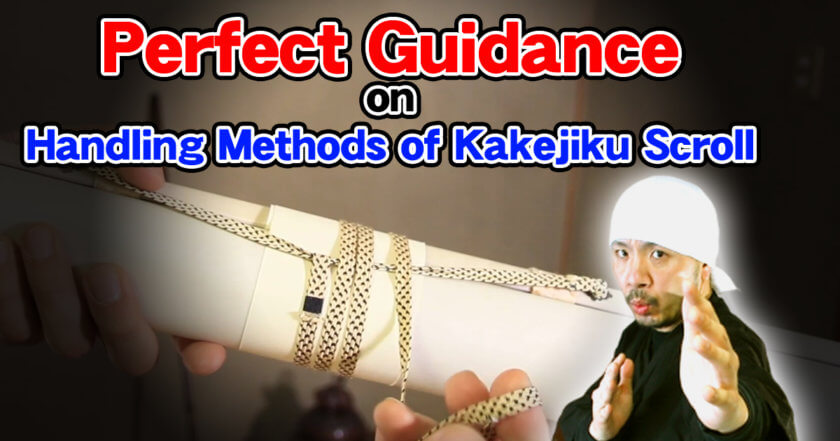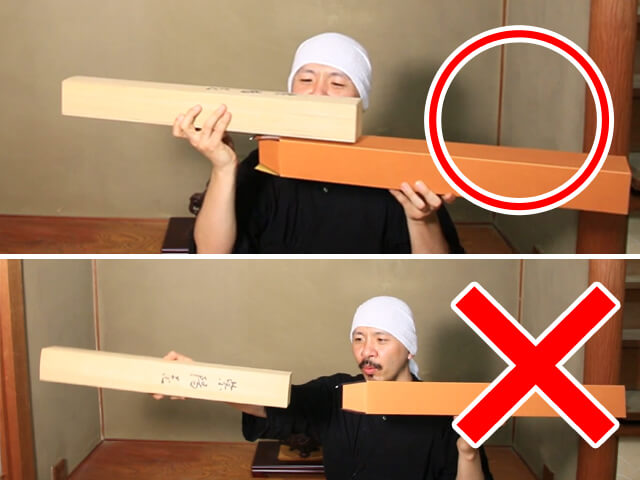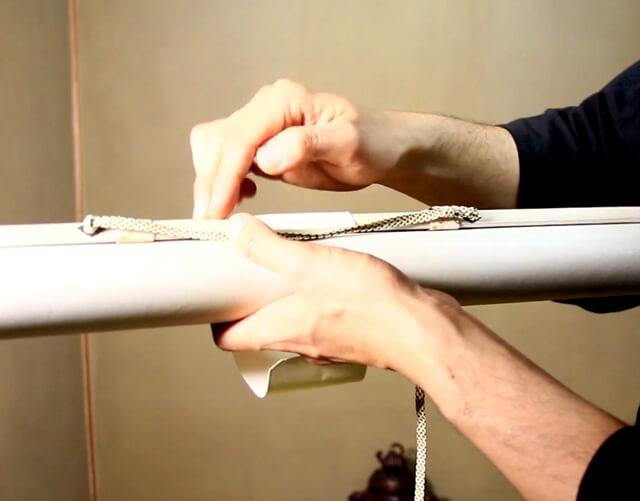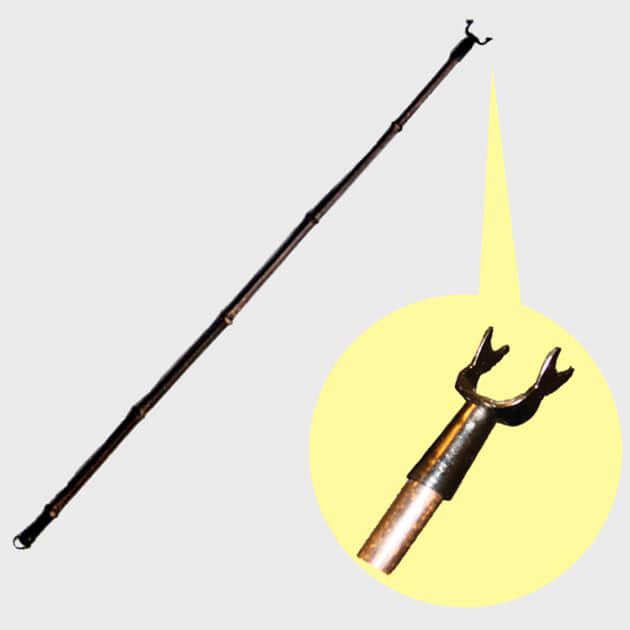Perfect Guidance on Handling Methods of Kakejiku!

Perfect Guidance on Handling Methods of Kakejiku! The Knacks and Points to Be Noted when Display, Store and Wrap the Piece with Cord
This time, I am presenting the guide to assumingly, the most common inquiries we receive which are ‘Perfect Guidance on Handling Method of Kakejiku! The Knacks and Points to Be Noted when Display, Store and Wrap it with Cords.’
I will give a focused explanation of how to store a kakejiku, especially the use of the cords as questions over the issue are frequently received. However, I would say how to display one couldn’t be so complicated.
Frankly speaking, I flatter myself that I am probably the fastest kakejiku roller in the world.
As contents of a video shot previously, on a trial basis, I counted the seconds taken when I rolled up a kakejiku my socks off and to my surprise, the outcome did not even reach to 30 seconds. The video below is proving this. (Sorry, the Japanese only.)
I am sure that a person who is capable to roll up and store a kakejiku within 30 seconds will be hardly found anywhere in the world and that makes me confident about being the world’s fastest man as for rolling it up. Such a man, I myself now would like to explain the method of rolling up a kakejiku.
Contents
Handling Methods of Kakejiku: Displaying Methods
Taking a Kakejiku out of the Box then Untying the Cords
I start off with the method of display. In most cases, a brand new kakejiku that was purchased is in a box similar to the one seen in the picture below. This outer box is called ‘Tatō’ or ‘Tatōshi’.

Firstly, remove the paulownia box from the outer box which can be orange or brown depending on the make of the inner box.
Please pay attention, only with the right direction, the paulownia box can correctly slide into the tatōshi. The lid of the box should face upward to be put in. Please be aware, in case the box was forcefully pushed in while being turned sideways, the tatōshi will be torn. The box will be stored smoothly if you avoid the forcible way.

Nextly, remove the paulownia box from the tatōshi and open the box and please note, the lid also has to be placed on its box with a certain direction. Open and close the box with a direction of the lid which lets the cover firmly close its box.

Closing the box with the lid the wrong way around, the box may not be closed properly, and pushing the lid forcefully against the box could cause a crack on the box or a gap along with the joint parts between the lid and box, leaving the box unattractive. For that reason, make sure the direction is correct before opening and closing the lid. With the right way of closing, the touching parts will be leveled out.

For peace of mind, you could always put a mark on the joint area with the lid in the right direction. Most of kakejikus we deal with are stamped to make out the direction.

Opening the lid and taking the kakejiku out from the paulownia box.

Then, untie the cord by pulling sidewise.
Regarding the name of the cords, a cord used for hanging a kakejiku is called ‘Kakeo/Hanging cord’.

Kakeo
A cord utilized for binding a kakejiku is called ‘Makio/Wrapping cord’.

Makio
Hang down makio in the rear and slide it to the end of the string.

Most of the time, the action is not necessary, yet I do so whenever I could as the cord can be seen through the artwork depending on the place to display.
There is a case of a piece of paper being rolled with a kakejiku and the paper is called ‘Makigami’.

Makigami
It wouldn’t be used for displaying a kakejiku so it will be removed. The piece of paper is still be utilized to store a kakejiku so do not throw it away. I would keep it in the paulownia box.
The purpose of the use of it is cushioning, protecting a kakejiku against makio which could leave marks on it when directly binds one for its storage.
Displaying
Now then, let’s display this kakejiku here, in an alcove.

A tool called ‘Yahazu/ Bamboo stick’ works well with hanging a kakejiku. The metal-tipped tool is made by a bamboo stick.

If it hasn’t been at your fingertips yet, I do recommend getting one. The following links may help.
The metal tip is designed to catch kakeo so as to hang it on a hook on a wall of an alcove.
What makes yahazu worthy is an unspoken basic rule which does not recommend stepping on an alcove.
An alcove is a room for decorating something precious. Therefore, stepping into there is considered to be ill-mannered.
So I would advise you to use the tool which enables you to hang your kakejiku with kakeo remotely staying out of an alcove. – Frankly, even for elsewhere, not necessarily an alcove, taking a stool to decorate and remove a kakejiku in a high position is simply, bothersome isn’t it? Yahazu will clear up those problems in one go so I very much recommend it.
Making use of yahazu, once hang the kakeo securely on the hook at the alcove, roll down the kakejiku gradually.


Please roll down the kakejiku slowly supporting it with your hand as far as the piece is wholly opened. Leaving the hand suddenly in the middle of the procedure must be avoided otherwise the kakejiku opens in once and that impact will strain the piece and cord.
Principally, a kakejiku is supposed to be rolled down unhurriedly assuming there are admires surrounding it whose pleasure is feeling thrilled by the sight of the kakejiku gradually revealing its content before their very eyes. So please do so little by little in a sensitive manner.
A pair of strips of cloth or paper found at the upper part of kakejiku is called ‘Fūtai’. They aren’t yet drooped down when a kakejiku is opened.

Fūtai
The formal way of displaying a fūtai is leaving the separated two strips drooped down so untie the ornament with a yahazu and the like.

Lastly, ensure that the kakejiku is displayed horizontally and that ends my instruction on displaying a kakejiku. I’m sure you find it fairly easy do you.
Another method of hanging kakejiku is available, which is for a short kakejiku. A usual way of displaying creates an unbalanced scarce space under a short kakejiku which looks unsightly for many of us. Nevertheless, to solve this dilemma, a tool called ‘Jizaigake/Height-adjustable stick’ which enables you to adjust the position of your kakejiku is on the market so please make good use of the tool.
If you are interested, check the video below previously shot as an introduction of the tool. (Sorry, the Japanese only.)
Links for purchasing.
I have almost never felt the needs for jizaigage from our customers abroad since most of them decorate their kakejiku on the wall of their room, not in an alcove unlike domestic customers who display it at the designated place, an alcove where the adjustment for a shorter kakejiku is required. Assumingly, the tool is not really necessary as their kakejiku is put on a show in the best position with a hook or a pushpin in the first place. I once introduced the tool to our foreign customer but she said ‘No thank you.’ being not sure about the usage. That was yet another thing I leant since I started dealing with customers from overseas.
This concludes the displaying methods of kakejiku.
Handling Method of Kakejiku: Storing Method
Better Not to Roll up a Kakejiku on Tatami?
Now then, I’m talking about how to store a kakejiku.

When storing a kakejiku, quite a few owners move theirs on a tatami mat so that they can roll it up on the mat. I wouldn’t recommend this way.
There are a number of reasons, for instance, in case the mat isn’t clean the dirt would spoil the kakejiku. Besides, with this method of rolling, in most cases, a kakejiku is rolled being pressed with their palms.

Then almost all the time, the kakejiku isn’t rolled properly, ended up with the rolled part sticking out to one side.

Well, when it happens, it won’t get you anywhere and you would reluctantly roll it up as it is to the end by force…This is also and very likely the cause of damages on a kakejiku so I won’t recommend this method. Plus, the look of the kakejiku is clumsy, unattractive, and uncool so please, where possible, rolling up your kakejiku while it’s displayed on the wall.
Roll up a Kakejiku with It Displayed on the Wall.
Let’s move on to the method for rolling up a kakejiku while it is displayed on the wall.
Yahazu is used for storing as well. Although experts like us can roll up a kakejiku while holding the tool as we got used to it, it might be easier for the non-professionals to stand it beside, to begin with.

First of all, roll up the kakejiku holding ‘Jikusaki / knobs found at the both end of a cylindrical rod at the bottom’ with your both hands.

The key for the success is rolling it loosely at the beginning because doing so tightly is damaging for a kakejiku as well as making the piece untidy when it is rolled.

The common mistake is rolling with the rolled part sticking out to one side which complicates the process.

The knack for it is rolling up the kakejiku with your both thumbs lightly pressing its both sides. Make sure the kakejiku keeps the rolled part in by adjusting meticulously.

Around halfway through the rolling, hold the kakejiku with your left hand (for the right-handed) either with an overhand grip or an underhand grip.

Overhand grip

Underhand grip
Using an overhand grip speeds up the rest of the storing process but the way which seems as if grabbing a kakejiku doesn’t really give a civilized impression.

I imagine you would be handed something valuable with an underhand grip. It’s unthinkable a retainer receives their reward from the king with an overhand grip, isn’t it?

Speaking personally, kakejikus that are another various articles should be hold from below with an underhand grip rather than an overhand grip as a matter of courtesy.
Holding with your left hand, take the kakejiku off the hook by the yahazu with your right hand.

Unless you are conscious of the angle of your left elbow and wrist at this point, the kakejiku could snap therefore, to avoid it happening it’s vital to hold the piece keeping it droop down straight adjusting the angles where possible.

Wrong angles of your elbow and wrist result in fractures on the kakejiku.

Holding it plumb is essential.
At the next stage, as your left hand has to shift to an overhand grip, the practice will take a little extra time.

We roll a kakejiku with an underhand grip in front of our customers though where we ought to roll a great number of kakejikus in a limited time such as an exhibition, we may carry on the task with an overhand grip. We decide which way based on the priority, good manners, or efficiency depending on the circumstance.
Then next, roll up the kakejiku to the top by holding the jikusaki. Please note, as this is a very common mistake which is rolling a fūtai up in a kakejiku and you should never do so.

Leaving the condition for a day, the fūtai tunes into a state that seems like legs of dried squid when the kakejiku is opened up which is unbelievably tricky to restore. In the worst case, it won’t return to its former state so again, please try not to do so.

It’s curved in an arch shape like a squid’s legs.
Roll up to the top with the fūtai hanging down from the piece.

When roll up to here, fold the fūtai horizontally at a pre-made fold before rolling up completely.

The same fabric as the one for ‘Ten / The upper part of kakejiku’ is used for the lining of a fūtai so store the kakejiku with the both parts seemed beautifully blending into each other when the strips are folded.

Ten
After that, roll up the kakejiku with the ‘Makigami’, I talked about at the beginning, by sliding its edge into the piece. The paper prevents a cord /makio from leaving a mark on a kakejiku.

Makigami

Tuck it in by sliding its edge into the kakejiku.

Wrap up the kakejiku with the makigami then bind the part with the cord.
When it’s done, pull and suspend the cord/makio in front of the kakejiku.


Once the cord is placed in front, finally bind it round the kakejiku.
A typical way the amateur carries out is binding a kakejiku by revolving the cord around the piece which is not only difficult but the cause of a slip-up. Specialists like us will never perform this method.

Do not revolve the cord itself around a kakejiku!
First off, pull the cord forward and rotate the kakejiku backward at the same time as if you wind the cord onto the piece by revolving the piece.


Wind the cord onto the kakejiku by rotating the kakejiku itself.
Then revolve the piece rearward with your left hand and wind the makio onto it pressing its contact point with the piece with the thumb of your right hand holding the cord while adjusting its position so as to make a row of it.

As you see the picture below, binding a kakejiku with a cord with the support of your right thumb will prevent overlap and a gap between the winding cord, letting you bind up a piece neatly.

The row of the makio tidily wound up is formed.
Of course, to wind up while squeezing a kakejiku is out of question. Bind your piece with an adequate strength which allows a certain looseness so as not to cause damage.
As you see, a little part of the makio is left after winding it around the kakejiku 3 times.

Create a ring with the extra part of the makio picking by your right fingers.

The ring is to pass under the horizontally set cord / Kakeo.

Kakeo
To start with, pass the ring under the right side of the kakeo which has been bound by the makio.

Then, pass the ring under the left side of the kakeo.

When the cord is formed in a shape that looks like a hiragana character ‘へ‘, it’s done.

The shape resembling a hiragana character‘へ’.
Binding this way, the next time the kakejiku is opened the makio will be undone without a mess by just pulling the end of it.


Being right-handed, I wound the makio round the kakejiku to the right this time yet either direction would work. Our managing director who is left-handed does so to the opposite direction still, it is not the problem. Both ways will be fine.

See how winding the cord around the kakejiku to the left looks like in the picture above.

Passing the ring under the cord will be the other way round too.

When undo the makio, pull it to the left as well.
That is all for the method of winding the cord round a kakejiku for storage.
How smart someone will look if they manage to execute those series of actions fast and smoothly. The skillfulness is the benchmark that differentiates the expert from the amateur. Can you imagine, a specialist is trying the techniques being all flustered. Terribly uncool…isn’t it.
The Winding Method of Makio with the Close-up Pictures
Here is how to wind the cord, introducing again with the close-up views.
First of all, pull the makio forward.

Wind the makio onto the kakejiku to the right direction pressing both the cord and the piece with your right thumb. This support of your thumb is the key for bind up a piece neatly as doing so, an overlap and a twist of the cord, as well as a gap between the lines of the cord, will be prevented

Wind the makio onto the kakejiku pressing its contact point with the piece with your thumb.

The row of the cord will be tidily made leaving no space.
Without the support of the thumb, the space between the winding cord is likely made.

Although the space can be tidied up at the last step, the look of it is awkward and rather impolite and what is worse it may cause hitches. Accordingly, it is best to wind pressing the point with your right thumb.

Then pass the ring under the horizontally set cord / Kakeo.

Kakeo
First, pass the ring under the right side of the kakeo. For easier understanding, I’m instructing you to make the ring. Even so, without making it, we pass the makio under the kakeo pushing it with our right thumb as if squeezing it in.

Then next, pass the ring under the opposite side of the kakeo.

The cord is formed in a shape resembling a hiragana character ‘へ‘.

Mistakes are hardly made if ensure that a makio must be passed under both the right and left sides of a kakeo.
Binding this way, the makio will be undone without a mess by just pulling the end of it next time you open the kakejiku.


Storing in a Paulownia Box
Then move on to the step of storing the rolled kakejiku in a paulownia box. Please note, there is the right direction for placing a kakejiku in the box. – Most people have no idea about this.
The part of the box ‘Makura ‘is designed to set a jikusaki and the size of its right and left sides differs.

Makura

The sizes of the two parts are not the same. Pointing at the larger one.
Store the kakejiku placing it as if lying on its back toward the larger part of the makura. Of course, lying on its back, the part is called makura/Pillow. Well, rarely but still some people lie on their stomach when sleep but if you could ignore the fact this time… It’s lying on its back, full stop.

Storing a kakejiku the other way round results in a smudge on and damage to the piece by the lid and the box may not be closed properly so please make sure your kakejiku is set in the makura with the right position.

Close the lid of the paulownia box. As I mentioned earlier the lid also has to be placed with the right direction so close the box with the direction the lid is firmly closed.

With the right way of closing, the touching parts of the lid and box will be leveled out.

Be careful that the cord doesn’t get caught between the lid and box as the cord could be cut later on.
Lastly, put the paulownia box in the tatōshi. Again, only with the right direction, the box can slide into the tatōshi so please keep it in mind.
You usually open the lid of the paulownia box upward don’t you? Not sidewise. Yes, the correct position of the box is keeping the lid with the face upward. Store the box in the tatōshi in the state.

Putting the box in with it turned sideways, the tatōshi will be torn. You should never try this way.

Although the wrong way is something you easily notice, still I’ve witnessed this mistake on several occasions so please be aware and keep it in mind.
Conclusion
I hope you find this helpful.
I entered into details of displaying and restoring methods of a kakejiku on this article.
It would make me happy if this could assist you in mastering how to handle a kakejiku.
For a better understanding, I uploaded a video clip to watch together with this article so if you could utilize it as well.
If you have a further question, you could contact us by either the comment box of the video or our inquiry form.
We get back to you with the answer as far as we possibly could and thank you in advance for your cooperation.
Thank you for reading this to the end.
MOVIE: Perfect Guidance on Handling Methods of Kakejiku! The Knacks and Points to Be Noted when Display, Store and Wrap the Piece with Cord
(Sorry, the Japanese only.)

